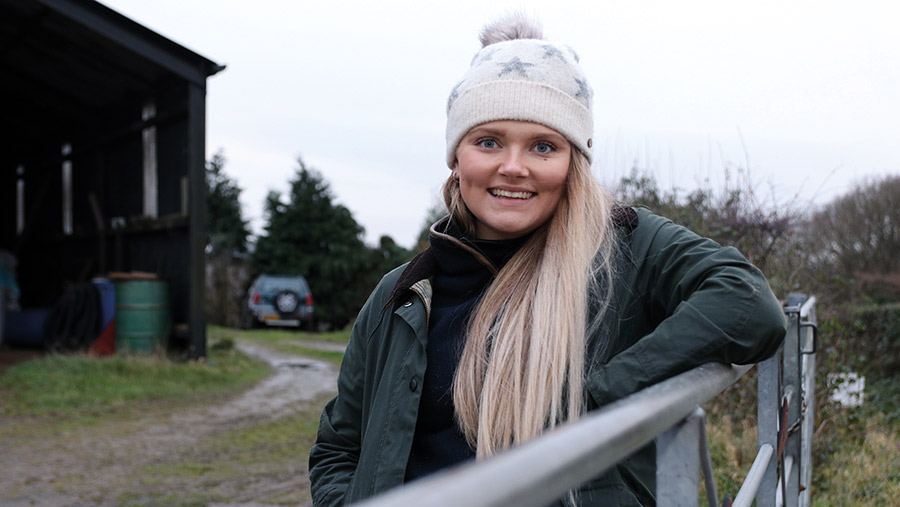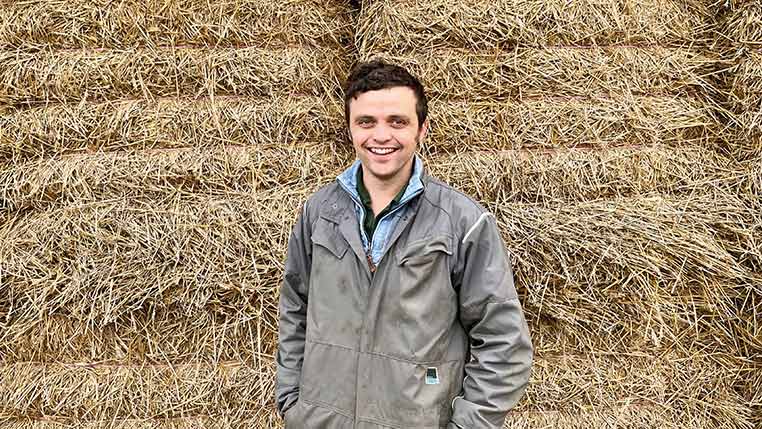New Farmlife columnists’ hopes for 2022
Thanks to everyone who entered our Farmlife columnist competition. There were many super entries, but we picked our favourites, and the two writers will be regular contributors to our Farmlife page in 2022.
The winners were Lucy Nott and Mike Neaverson, find out about them below and read the pieces they submitted in response to our request to write an article titled “2022”.
See also: Bridgette Baker: Time for women to get in the (tractor) driving seat
Lucy Nott

© David Nott
Lucy and her husband, a sixth-generation farmer, live on a 100ha arable farm in Worcestershire with their two children.
She has a degree in drama and a postgraduate in sports sociology and has worked as a fundraising manager for the RNLI and BHF.
“So I have new eyes on the ag world and I’m keen to find my place and make my mark,” she says.
“We have a passion for regenerative agriculture and aspire to transition our farm to a regenerative system.
“As well as this, we have submitted a Countryside Stewardship application for 2022 and are part of the Sustainable Farming Incentive pilot.
“We hosted our first Leaf Open Farm Sunday (LOFS) this year and I am now the LOFS ambassador for the West Midlands.
“We are also planning on trialling lots of new things on our farm over the next few years, so I should have plenty of real-life anecdotes to write about.”
‘Turn that TV-shouting passion into action’
I don’t know about you, but mentally I’m still in 2019, still trying to process 2020, and I can just about accept we’re at the end of 2021. So the thought of 2022 is almost overwhelming.
We’ve been through a sea of change during the past two years and 2022 is shaping up to be the same.
My husband, Ben, and I are standing on the precipice of 2022 as two plucky 27-year-olds, scratching our heads trying to work it all out.
We’ve got supply-chain issues, sky-high fertiliser prices, the end of the BPS, working out the ELM scheme, trialling the SFI, and a changing climate to top it all.
As we progress through our succession, it’s clear we can’t rest on our laurels, plant some cash crops and hope the markets treat us well.
COP26 has seen agriculture thrust into the spotlight again. Never before has the public been so interested in how their food is produced. But this is no golden ticket. It is a critical eye that is being cast over us, with plenty of misinformation in circulation.
I’m sure you, like me, have shouted at the TV more than once this year. Right now, we are at a turning point. We need to take that TV-shouting passion and get the British public on side and backing British farming.
As a sector, we need to be the loudest voice in the room and shout from the barntops about our high-quality produce.
It’s an opportunity to educate the public on the sustainability of British food and empower the consumer to make informed choices when shopping.
With food prices predicted to rise, we need to add value back into food – because the fact it nourishes and sustains us appears to not be enough anymore. Our produce needs a story. People buy from people.
So how is the mere-mortal family farmer supposed to take on this huge task? The starting point is simple. Talk. Whether that’s in person or online, to your best friend or the postman.
Take the opportunity to answer questions and talk about what you do. What’s rudimentary to you is fascinating to others. You don’t need to be in direct sales or have a large social following to tell your story and make a difference.
On our farm, we’ve opted into Educational Access through our Countryside Stewardship scheme and will be welcoming school visits.
We’ve signed up to Farmer Time and speak to a class of children each week about life on our farm. We’ll also open our gates on Open Farm Sunday.
Now more than ever, as custodians of the land, it can feel as if the weight of the world is on our shoulders. So let’s not fixate on the vastness of 2022.
Focus on your patch, the changes you can make, the conversations you can have and the story you can tell.
Happy new year? We’ll wait and see…
Mike Neaverson

© Mike Neaverson
Mike is a potato farmer and independent agronomist from Lincolnshire.
A former student columnist for Farmers Weekly, he had a year farming in New Zealand, a couple of stints in Antarctica and five years working in management for a big farming companies.
“I came back to South Lincs and set up my own company in 2017 and have started my potato operation from scratch, operating entirely on rented cropping licence land.
“My dad is a 200ha tenant arable farmer here and I am involved practically in that business, too.”
‘No bottle of wine should ever cost me more than £6’
I know absolutely nothing about wine other than that white is for fish, red is for beef, and rosé is for rewilders.
Selecting the right Christmas bottle from the booze aisles presented, as it always does, quite a challenge this year. There’s a danger of getting a bit overwhelmed, just like I do as a simple potato farmer slowly getting sunburned at a wheat trials day.
With no specialist knowledge, I have had to develop some simple rules to help in the vinegar-avoidance process. I share my guidance here, not because I am touting for business as a PR consultant to Blue Nun. Rather, I’m sure there’s something in it for us in farming, too.
Let’s be realistic. The sad fact of the matter is that I don’t really care about wine as long as it tastes nice and gets me adequately smashed; my customers don’t really care about my potatoes as long as they look nice and can be adequately mashed.
The first rule of plonk procurement is that you should only ever buy wine with a matt label. I don’t actually know what a merlot is, but somehow using a sticker that isn’t shiny adds at least a couple of quid to a cheap one.
Second, I am an absolute sucker for a motif. Print an abstract drawing of a bicycle or a cockerel on the bottle and I’m a buyer.
Last week I bought one purely because it had an old mugshot of an Australian criminal on the label. Not such a g’day for the old fella.
If I am so easily swayed by a dull label and a bad drawing of a footprint, the same must be true of some of our agricultural customers.
Differentiation of our produce is vital in a busy marketplace, but almost impossible for commodity-producing corn-farmers to achieve. It’s why my focus is now increasingly on where I can try to do it.
The other requirements concern cost – the bottle must usually be on offer, to subconsciously promote value. And because I am but a humble potato farmer, no bottle of wine should ever cost me more than £6. I am not a BPS-claiming arable baron, after all.
Inflation has meant that this price limit has had to rise over time. It was possible to get a fairly regrettable bottle of Flowery Mountain for £2.79 when I was a student a decade ago. The same bottle is now well over a fiver.
Yet many agricultural prices have been stagnant despite rampant increases in our costs – none more so than in the past few months. So as we enter 2022, it’s time for a few business resolutions.
For me, it’s to further focus on quality, differentiate my output, and do my best to push some of our massively increased costs down the chain to conserve a margin.
And to drink more ale. Happy new year.
